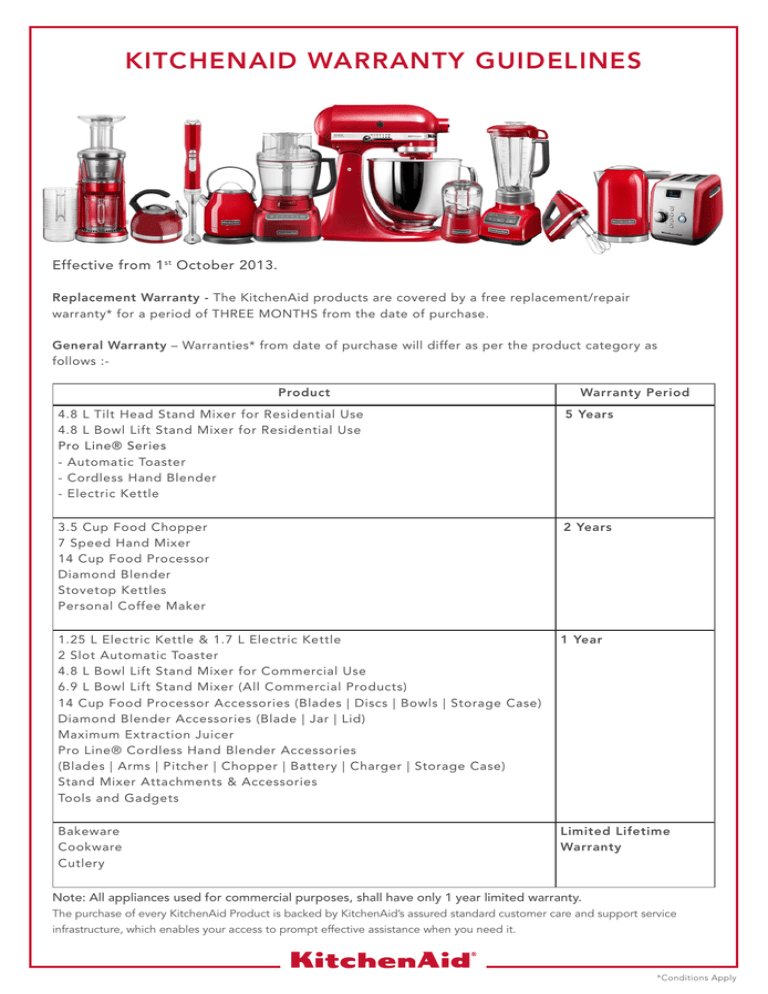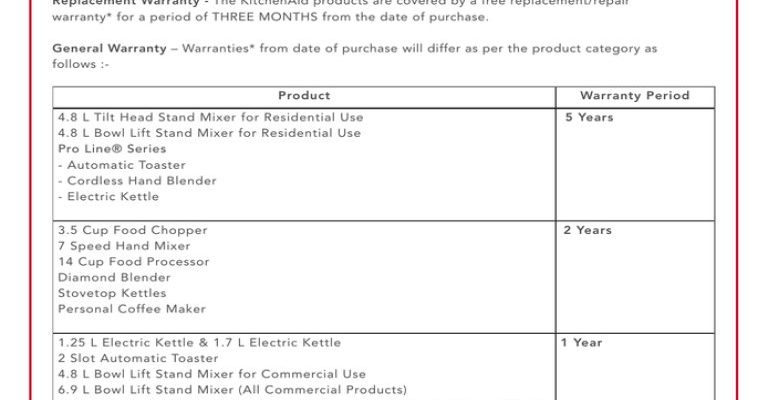
Honestly, reading through a warranty shouldn’t require a legal degree or a magnifying glass. If you’re standing there, Kitchenaid appliance in hand, asking yourself what’s actually covered (and what’s not), you’re not alone. Let me walk you through it, one step at a time, so you can enjoy your toast or tiramisu without any warranty worries in the back of your mind.
What Kitchenaid’s Warranty Actually Promises
Here’s the thing: a warranty is basically KitchenAid’s pinky promise to fix or replace certain problems that aren’t your fault. It’s not a blanket insurance policy, but it does give you some peace of mind. The standard KitchenAid warranty for most major kitchen appliances, like refrigerators and dishwashers, covers defects in materials and workmanship—meaning if something’s wrong with how your appliance was made or put together, KitchenAid will handle it.
But there’s some fine print. For example, if your stand mixer’s motor fizzles out after a couple of uses, and it wasn’t your fault, you’re probably covered. However, if it fell off the counter during a late-night cookie spree (I get it), that usually isn’t on KitchenAid. Essentially, the warranty steps in for manufacturer mistakes, not for general wear and tear or, say, a run-in with gravity.
Tip: Every appliance has its own specific warranty details, so it’s worth checking the booklet or KitchenAid’s site for the exact terms for your model.
Length of Coverage: How Long Does the Warranty Last?
You might be wondering, “How long are my KitchenAid appliances covered by warranty?” The answer depends on what you’ve bought. Typically, for most countertop appliances—think blenders, mixers, and food processors—the warranty lasts for one year from the date of purchase. This means if something major fails within that first year (and it wasn’t caused by dropping, misusing, or not following instructions), KitchenAid will repair or replace it.
For bigger built-ins like ranges, refrigerators, and dishwashers, the warranty can last up to one year too, but sometimes there are extra coverages for specific parts. For instance, the motor on a KitchenAid stand mixer might have a longer warranty than other parts, just because it’s so central to the appliance’s function.
There are also “limited warranties” that extend coverage on certain components—like the sealed refrigeration system—sometimes for up to five years. That means if the sealed system inside your KitchenAid refrigerator fizzles out in year three, you could still be in luck. Always check the details that came with your appliance, and don’t be afraid to reach out to KitchenAid’s support for clarification—it’s literally their job to help.
What’s Covered: The Good Stuff
Let me break down what KitchenAid’s warranty usually *does* cover. Here’s a quick hit list:
- Defects in materials or workmanship: If something was put together wrong at the factory, or a key part is flawed, it’s usually covered.
- Replacement parts and labor: During the coverage period, KitchenAid typically pays for replacement parts and the labor to install them. You don’t have to pay for the repair technician’s time or the part itself.
- Shipping: For smaller appliances, KitchenAid often covers return shipping both ways (double-check your paperwork to be sure!)
- Specific components: Some appliances have extra coverage for parts like compressors, sealed systems, or drive motors, even after the main warranty expires.
Imagine you’re using your KitchenAid food processor for a salad party and something inside just won’t spin, even though you did everything right. If it’s a defect, KitchenAid would either fix it or send you a new one—at no charge to you during the warranty period. That’s the core promise.
What’s Not Covered: The Limits You Should Know
Here’s where the warranty gets specific—and, honestly, a bit less fun. There are limits on what KitchenAid’s warranty will fix or replace. It’s not a catch-all for every kitchen mishap.
- Accidental damage: Dropped your blender? Sorry, but that’s not covered by the manufacturer’s warranty.
- Normal wear and tear: Things like faded buttons, small scratches, or general aging aren’t included. The warranty’s for big issues, not just old age.
- Improper use: Used your mixer as a bread machine or ran your dishwasher with the wrong soap? That’ll void the warranty.
- Unauthorized repairs: If you tried to fix it yourself (or had a non-KitchenAid technician do the job), and something goes wrong, it’s usually not covered anymore.
- Consumable parts: Filters, light bulbs, and other things you’re expected to replace regularly aren’t covered under the main warranty.
If it helps, imagine the warranty as a helpful umbrella: it’ll keep you dry in a big storm (manufacturing defect), but it won’t stop you from getting splashed if you jump in a puddle on purpose.
How to Make a Warranty Claim—Step by Step
Okay, let’s say you’ve noticed your KitchenAid appliance is acting up and you’re pretty sure it’s a defect. Here’s what to do:
- Find your proof of purchase. This could be your original receipt, a digital order confirmation, or even a bank statement showing the sale.
- Read your warranty booklet. Double-check that your issue is covered (and that you’re still within the warranty window).
- Contact KitchenAid support. You can call, email, or use the website. Be ready to share your model number, purchase date, and a clear description of the problem.
- Follow their directions. KitchenAid may ask you to send photos, describe the code or reset steps you’ve tried, or even ship the appliance to a service center.
Don’t worry if this feels overwhelming; their support team is used to helping beginners troubleshoot, code, reset, or pair accessories. They’ll guide you through each step, so you don’t have to play appliance detective on your own.
Extended Warranties and Alternatives
Here’s where it gets interesting. Besides the standard warranty, KitchenAid (and many stores) offer *extended warranties*. These cost extra but can stretch your safety net for a few more years.
- Extended Service Plans: These work a lot like the regular warranty, but for a longer period—sometimes up to five years.
- Coverage details: Always check what’s included (and what’s not). Some extended plans even cover accidental damage or power surges, but not all.
- Third-party vs. manufacturer: You might see extended warranties from places like Best Buy or Amazon. Sometimes, these have different rules or claim processes than KitchenAid’s own plan.
It can be tempting to skip an extended warranty when you’re checking out—it’s one more thing on a growing bill. But if you’re investing in a really expensive appliance or you know you’ll put it through its paces, that extra peace of mind can be worth it.
Comparing KitchenAid’s Warranty to Other Brands
If you’re comparing KitchenAid to other kitchen appliance brands, you’ll notice their warranty is pretty typical, but not always the best in every department. For instance, some brands offer two-year standard coverage on small appliances, while others (like KitchenAid) stick to a year.
For major appliances, KitchenAid’s warranties often closely match those from GE, Whirlpool, or Samsung: one year for most parts and labor, plus additional coverage for sealed systems or motors on select models. The real difference often comes down to:
- Ease of claim process
- Customer support quality
- Availability of repair techs
- Speed of replacement
Some folks swear by KitchenAid’s support team—others have horror stories. Your experience may vary, but knowing how the warranty works ahead of time gives you an edge, whatever brand you pick.
Tips for Keeping Your Warranty Intact
If you want to keep your KitchenAid warranty in good standing (trust me, you do), here are a few golden rules:
- Register your appliance. It’s not always required, but registering makes things easier if you need to claim later.
- Save your receipt. No proof of purchase? Your claim might hit a dead end.
- Follow the manual. Using your appliance in ways not intended (like hacking your stand mixer as an ice crusher) can void your warranty.
- Don’t DIY the repairs. As tempting as it is to play engineer, unauthorized repairs can disqualify you for warranty coverage.
- Keep it clean. No, really. Failing to care for your appliance the way the manual recommends can sometimes give KitchenAid a reason to deny your claim.
Think of the warranty like a good relationship: it works best when both sides play fair and follow the rules.
In Closing: Is the KitchenAid Warranty Enough?
Navigating appliance warranties isn’t always glamorous, but it’s a smart move if you value your time, money, and sanity. KitchenAid’s kitchen appliances warranty does a solid job of protecting against major factory mistakes, but it won’t back you up for every kitchen mishap or “oops” moment.
Keep your receipts, treat your appliance kindly, and don’t be afraid to ask KitchenAid for help if something seems off. That way, you can get back to making pancakes—or banana bread or fancy cocktails—without fretting about what happens if your mixer or fridge calls it quits.
In the end, a good warranty is like a good spatula: you don’t realize how much you need it—until you really, really do.
